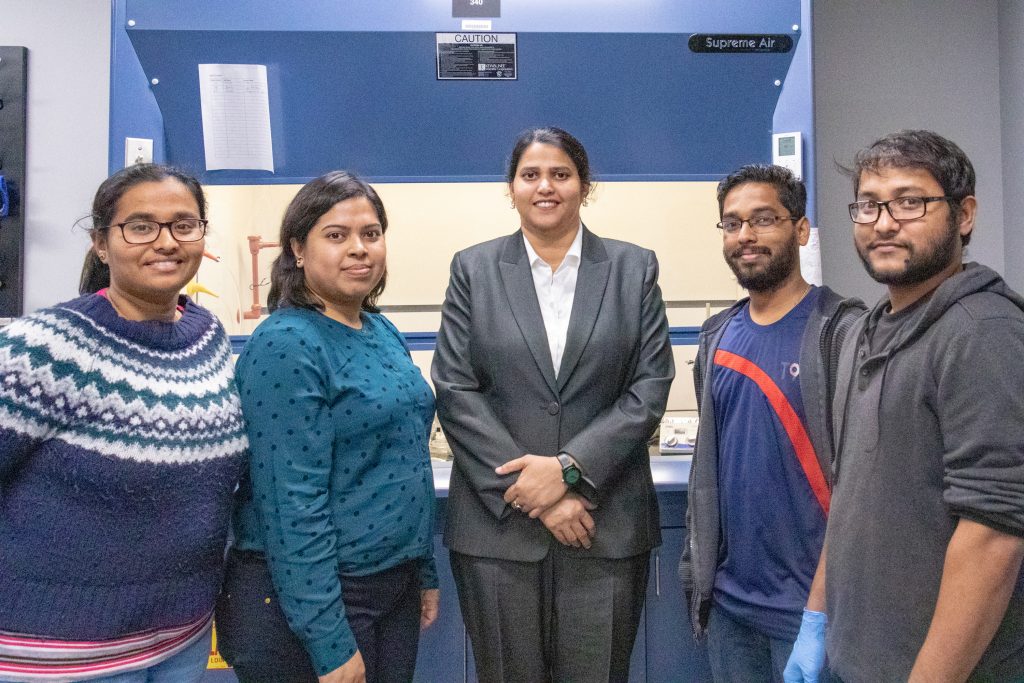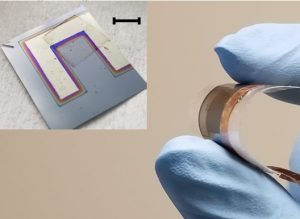Engineering Professor Advances Semiconductor Technology Using Biomimetics
March 2019
At UCF’s Next-Generation Electronics Laboratory, Assistant Professor Tania Roy is leading an interdisciplinary research team to develop innovations in electronic and optoelectronic devices. “My main focus is energy-efficient devices,” said Roy. “In our cell phones and computers, there are billions of transistor devices that run them. We need to reduce the power or energy consumption of each individual device so that we can run them at lower power overall.” To that end, Roy and her team are trying to use new physics to build devices that will work with lower voltage. She recently talked with Tech Transfer about her current work, which includes novel biomimetic design approaches to solar cells and low-power semiconductors.

Members of the UCF Next-Generation Electronics Laboratory (left to right): Adithi Krishnaprasad, Sonali Das, Tania Roy, Durjoy Dev and Molla Manjurul Islam.
A thin, flexible solar cell that captures sunlight the way a leaf does
“One part of my research is solar cells,” said Roy. “Because renewable energy is what we all are looking for—right? Solar cells are the cleanest sort of energy-producing devices. As an engineer, I’ve always wanted to work on solar cells, and now as a faculty member, I have the independence to pursue such areas that I’m passionate about, and which I think can contribute to society as well.”
That passion has resulted in a new invention that manufacturers can use to create ultrathin, two-dimensional, flexible solar cells that harvest light better than today’s conventional solar cells. In developing the invention, Roy’s team sought to reduce the thickness of solar cells to conserve materials and to cut down production costs. However, an obvious downside to making solar cells thinner is that there’s less material to collect and trap the light needed to produce more power. “Conventionally, one would use a silicon solar cell and create textures in the silicon substrate, but that would compromise the electrical performance of the device,” Roy said. “So we have to create some light-trapping structures. That’s the engineering part of it, and that’s when Sonali came up with this very, very brilliant idea.”
After analyzing various kinds of light-trapping schemes in ultra-thin solar cells, co-inventor and post-doctoral scholar Sonali Das looked at nature’s way of capturing light. “I was thinking that a leaf, throughout the day, is preparing its food with the help of sunlight. So if a leaf can actually trap the sunlight and prepare the food efficiently, then why not mimic the structure of the leaf in our semiconductor device to trap the light and convert it to electricity,” said Das. Using thinned down layers of materials (such as graphene and silicon) and spherical nanoparticles (lossless in the solar spectrum), the team built a solar cell that effectively collects and traps sunlight from different angles better than conventional solar cells do. The new solar cell architecture also yields a structure that is lightweight, flexible and portable. When viewed through a scanning electron microscope (SEM), the solar cell shows “beautiful areas of leaf-like features,” Roy said.
Both Roy and Das noted that the new technology enables manufacturers to cost-effectively mass-produce the leaf-like solar cells and are not limited to using specific materials. They envision that the technology will facilitate the future use of ultra-light, self-powered devices.
“This type of solar cell could power up any other electronic devices that we use for monitoring our health, any sort of flexible, wearable devices on our bodies and any other gadgets,” Das said. She added that as the light trapping scheme is universal in nature, it can also be implemented on semi-transparent light-weight flexible solar cell platforms which could be placed on the windows of homes and cars. More information about the invention is available in this technology sheet.
Low-power computation semiconductors that mimic the synapses and neurons of the brain
Besides making advancements in solar cells, Roy and her team are also working to develop semiconductors made of nanoscale artificial synapses and neurons that mimic the human brain. “Although the brain uses the maximum amount of energy in the entire body, compared to any electronic device, that energy use is minuscule,” Roy said. “If we can do that on a semiconductor, then we can make an artificial, lean, intelligent device that functions like the human brain.” One goal of the project is to create devices that can emulate the pattern matching capabilities of the brain, the same way that people can recall data and match it with their memories.
With grant funding from the National Science Foundation (CAREER), the team is currently creating single devices that can emulate a neuron or a synapse. The tiny devices will eventually be integrated into a bigger structure to make a circuit that operates on extremely low power and can do pattern matching. Made of ultra-thin, flexible, two-dimensional (2D) materials, the new integrated system will be lighter, faster and more energy-efficient than those used in today’s computers.
Benefits of collaboration and teaching
Roy credits UCF’s support of open collaboration among colleagues as essential to the success of her projects as well as any research project. “Without collaboration, we can’t function. We are collaborating with a lot of other faculty so that we’re able to pursue bigger goals.”
“I like everything about research. Every failure teaches us something. Nothing is really lost, and there is so much to look forward to every single day. We can choose whatever topic excites us, or whatever topic we think will be useful for society. Research is all about new things and learning new things. I wouldn’t have chosen anything else.”
She also emphasized that her approach to research is intertwined with teaching so that everyone benefits. “When I’m teaching my undergrad class, I’m learning something new which I can implement in my research. Whatever I’m learning in my research, I can teach to the students in my class.”
By Kathleen F. Snoeblen
